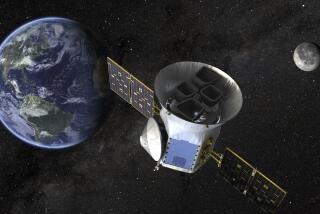Giant rogue planet, without a home star, may roam nearby heavens
Astronomers have discovered what they believe to be a rogue planet floating through space without a star. The super-Jupiter, called CFBDSIR2149, has a mass four to seven times that of our own gas giant, and is probably a scorching 800 or so degrees Fahrenheit. It appears to sit in a moving group of stars that, at a rough distance of 65 light-years, is just a cosmic stoneâs throw away from us.
Scientists first discovered the apparent planet using the Canada-France-Hawaii Telescope atop Mauna Kea in Hawaii, while conducting a survey of brown dwarfs, âfailedâ stars that arenât massive enough to start the nuclear fusion in their cores that would allow them to shine.
They later took a look with the Very Large Telescope in Chile. The strange object seemed to be keeping company with the AB Doradus Moving Group, the closest moving group to our solar system, and seemed too young be a brown dwarf: AB Doradus is a mere 50 million to 120 million years old, which would make the planet about the same age.
At an upper limit of seven Jupiters, the object just doesnât seem hefty enough to be a star. (Thirteen Jupiter masses seems to be the rough cutoff point between a really big planet and a really small brown dwarf.)
Researchers arenât quite sure how such an untethered planet comes to be: It may be that they form the standard way, from the ring of coalescing dust around a young star, and is later somehow kicked out of the system.
Such objects are a potential boon to astronomers looking to study planets throughout the galaxy. Stars shine so brightly that they blind observers to the dim planets around them.
Without interference from a nearby star, scientists may be able to glean more about the objectâs characteristics and even its composition, and learn a little more about where our solar systemâs inhabitants fit into the larger planetary pantheon, said Christian Veillet, former executive director (and current researcher) at the Canada-France-Hawaii Telescope.
âThe only planets we actually know very well right now are those around our sun,â said Veillet, who was not involved in the study. âNow the [question] is, how special are they?â
But the find, described in a paper released early Wednesday by the journal Astronomy and Astrophysics, isnât a slam-dunk case yet. The study authors are only 87% sure itâs traveling together with the AB Doradus Moving Group and isnât simply crossing paths. Theyâll need to keep watching CFBDSIR2149 before they can say for sure that itâs a planet.
Thereâs also a possibility the object is a brown dwarf, which would still be interesting, but for very different reasons, Veillet said.
Follow me on Twitter @aminawrite.






